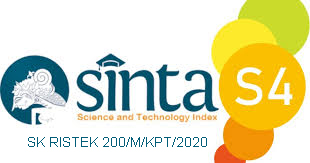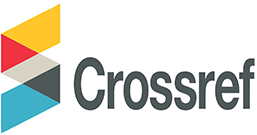Implementation of Social Network Analysis in the Spread of Natuna Issues on Twitter
Abstract
Currently, the growth of internet users has been accompanied by the development of applications that support interaction among users, which is called social media. One of the popular social media in society today is twitter. Data on Twitter can be presented in a graph structure visualization in nodes that represent actors and edges that represent relationships between actors. In an effort to find the most influential actors and actors who interact the most in spreading the Natuna topic on social media twitter, an analysis will be carried out using the Social Network Analysis method using the Degree Centrality approach. The data used in this study were taken from December 20, 2019 at 00.00 WIB to January 7, 2020 at 10.00 WIB consisting of 71,477 nodes and 147066 edges. The results of this study can be concluded that the @susipudjiastuti account is the most influential actor and plays an important role in social networking because the @susipudjiastuti account is the most linked account with 29755 links. Meanwhile, the @ shaktia704 account was the most active account during the data collection period, which reached 259 links.
Keywords
Full Text:
PDFReferences
R. Nugraha, “Trending Topik Twitter sebagai Sarana Penyebaran Isu Kontroversial,” www.kompasiana.com, 2020. https://www.kompasiana.com/nugraha88/5e1087aed541df79920f6b22/trending-topik-twitter-sebagai-sarana-penyebaran-isu-kontroversial?page=all (accessed Jan. 17, 2021).
L. Zhang, R. Ghosh, M. Dekhil, M. Hsu, and B. Liu, “Combining lexicon-based and learning-based methods for twitter sentiment analysis,” HP Lab. Tech. Rep., no. 89, 2011.
S. Fortunato, “Community detection in graphs,” Phys. Rep., vol. 486, no. 3–5, pp. 75–174, 2010, doi: 10.1016/j.physrep.2009.11.002.
B. Susanto, H. Lina, and A. R. Chrismanto, “Penerapan Social Network Analysis dalam Penentuan Centrality Studi Kasus Social Network Twitter,” J. Inform., vol. 8, no. 1, 2012, doi: 10.21460/inf.2012.81.111.
C. Kadushin, “Kadushin , Charles . Understanding social networks : theories , Kadushin , Charles . Understanding social New York , NY : Oxford University Press , Keen On Mass Comms ?,” vol. 18, no. April, pp. 2013–2015, 2012.
A. Marin and B. Wellman, Handbook of Social Network Analysis. 2009.
S. Wasserman and K. Faust, Social Network Analysis: Methods and applications. Cambridge University Press, 1994.
M. Tsvetovat and A. Kouznetsov, Social Network Analysis for Startups. 2011.
A. Bohn, I. Feinerer, K. Hornik, and P. Mair, “Content-based social network analysis of mailing lists,” R J., vol. 3, no. 1, pp. 11–18, 2011, doi: 10.32614/rj-2011-003.
F. Bloch and M. O. Jackson, “Centrality Measures in Networks,” SSRN Electron. J., no. January, 2016, doi: 10.2139/ssrn.2749124.
F. Y. Pratama, “Simulasi Jejaring Jalan Kota Pontianak Dengan Betweeness Centrality dan Degree Centrality,” Progr. Stud. Tek. Ind. Fak. Tek. Univ. Tanjungpura, pp. 1–6, 2018.
J. Zhang and Y. Luo, “Degree Centrality, Betweenness Centrality, and Closeness Centrality in Social Network,” vol. 132, no. Msam, pp. 300–303, 2017, doi: 10.2991/msam-17.2017.68.
G. Lohmann et al., “Eigenvector centrality mapping for analyzing connectivity patterns in fMRI data of the human brain,” PLoS One, vol. 5, no. 4, 2010, doi: 10.1371/journal.pone.0010232.
M. S. Setatama and D. Tricahyono, Ir., M.M., Ph.D., “Implementasi Social Network Analysis pada Penyebaran Country Branding ‘Wonderful Indonesia,’” Indones. J. Comput., vol. 2, no. 2, p. 91, 2017, doi: 10.21108/indojc.2017.2.2.183.
T. M. J. Fruchterman and E. M. Reingold, “Graph Drawing by Force-directed Placement,” Softw. Pract. Exp., vol. 21, pp. 1129–1164, 1991.
DOI: https://doi.org/10.31326/jisa.v4i1.899
Refbacks
- There are currently no refbacks.
Copyright (c) 2021 Ashif Dzilfiqar Thayyibi, Juliana Mansur

This work is licensed under a Creative Commons Attribution-ShareAlike 4.0 International License.
JOURNAL IDENTITY
Journal Name: JISA (Jurnal Informatika dan Sains)
e-ISSN: 2614-8404, p-ISSN: 2776-3234
Publisher: Program Studi Teknik Informatika Universitas Trilogi
Publication Schedule: June and December
Language: Indonesia & English
APC: The Journal Charges Fees for Publishing
Indexing: EBSCO , DOAJ, Google Scholar, Arsip Relawan Jurnal Indonesia, Directory of Research Journals Indexing, Index Copernicus International, PKP Index, Science and Technology Index (SINTA, S4) , Garuda Index
OAI address: http://trilogi.ac.id/journal/ks/index.php/JISA/oai
Contact: jisa@trilogi.ac.id
Sponsored by: DOI – Digital Object Identifier Crossref, Universitas Trilogi
In Collaboration With: Indonesian Artificial Intelligent Ecosystem(IAIE), Relawan Jurnal Indonesia, Jurnal Teknologi dan Sistem Komputer (JTSiskom)
JISA (Jurnal Informatika dan Sains) is Published by Program Studi Teknik Informatika, Universitas Trilogi under Creative Commons Attribution-ShareAlike 4.0 International License.


















